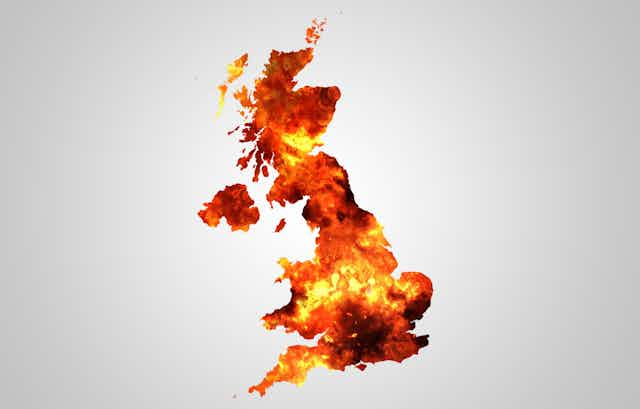While massive heatwaves are affecting southern Europe, China, the US and many other places, it’s rainy and not particularly warm in the UK. But that doesn’t mean there’s no risk of intense heat: on this exact week last year, the UK broke 40°C for the first time.
Even if countries were to deliver on their emission reduction pledges, set under the Paris agreement, the UN Environment Programme estimates that we will still see at least a 2.5°C rise in global temperature. For the UK, the new reality is that 40°C temperatures are possible and eventually will be commonplace, and the country must adapt urgently.
Adaptation means making changes to social, economic and ecological systems to reduce the impact of events like heatwaves. For example, creating green space in urban areas to provide a cooling effect that reduces the intensity of extreme heat. Yet although the government has just released a new proposal for preparing the UK, as researchers of climate change adaption plans we see too little being done.
Even before the Paris agreement required adaptation plans, the UK had already started to plan adaptation actions under the Climate Change Act 2008. On July 18, as required by law, the UK government released its third National Adaptation Plan (NAP3), following it being leaked a day early.
The government’s own official advisory body, the Climate Change Committee (CCC), was quick to criticise the plan. The chair of the CCC’s adaptation committee said the new publication represented progress on previous plans but “promising further action is not enough […] The scale of the climate impacts we are seeing make clear that resilience to climate change should be a much greater national priority”. These and other critics are right to highlight that too little is being done.
What risks has the UK identified?
Climate change projections indicate that the UK will experience hotter drier summers and warmer wetter winters. This will likely cause more flooding and more heatwaves. These projections have been used by the government to develop the climate change risk assessment, on which national adaptation plans are based. The NAP3 identifies eight priority areas for action, including the risk to health posed by extreme heat, the climate-related failure of power supply and collapse of supply chains.
In order to deal with these risks the UK has planned key actions to protect against extreme heat and flooding from sea level rise and rainfall. For instance one of the highest profile schemes is the Thames Barrier and associated infrastructure, which protects London from flooding. The Environment Agency recently reported confidence that the scheme was reliable to 2070 but had less confidence this would remain the case for the remainder of the century as the sea level rises.

Progress has also been made in building resilience into water supply and transport. However, insufficient progress has been made in health care, energy supply, telecoms and food supply, both in terms of policy development and action.
UK adaptation plans
The NAP3 will provide further structure, compared to previous plans, and delivery will be via an existing governance process. For example, integrating climate change into planning decisions via the National Planning Policy Framework. Changes have also been made to building regulations to include provision for overheating in new buildings.
This is useful, but there is still a significant amount of legacy infrastructure and buildings that are inadequate that are not being fully considered. A recent paper in Nature Sustainability estimated that in the UK there are around 570,000 homes and other buildings, such as hospitals, which are unable to deal with a projected 30% increase in the need for cooling associated with 2°C of global warming. Such buildings will need retrofitting with cooling systems, better ventilation and natural or artificial shading.

Cooling also needs to be considered in conjunction with other approaches such as urban planning, introduction of non-native, drought tolerant species and development of green infrastructure and public awareness campaigns. There is, therefore, still much to do.
The UK, like many countries, has numerous frameworks and plans, such as the Heatwave Plan, Green Infrastructure Framework, and National Infrastructure Delivery Plans. These all relate to or consider climate change. The national adaptation plan should, in theory, draw these together into one coherent approach. However, they are not integrated, don’t consider dependencies between sectors and issues and they lack suitable targets.
Adaptation is complex, involving numerous parties at numerous scales from the huge Thames Barrier to a few trees on the road outside your home. It cannot be captured by a single indicator. This lack of targets, and appropriate indicators and data is a key barrier – we sometimes risk not knowing if we’re investing in effective adaptation.
The UK could look elsewhere in Europe for inspiration. One analysis of adaptation plans for European cities identified Sofia (Bulgaria) and Galway and Dublin (Ireland) as the best quality. In Slovakia green infrastructure has been developed in the most socially-vulnerable areas of cities. Or it could look to Gujarat, in India, where district cooling schemes have reduced air pollution and reliance on air conditioning.
National adaptation plans have improved, but those that are actually coordinated at a national level, like in Ireland, are rare. As a result there are still trade offs. For example a reliance on air conditioning for cooling creates more emissions and is not affordable for everyone.
There is much more to be done to adapt to climate change and build resilience to severe heatwaves, floods and other extreme events when they do eventually occur. But it needs more focus and coordination by national governments to avoid significant and costly consequences.

Don’t have time to read about climate change as much as you’d like?
Get a weekly roundup in your inbox instead. Every Wednesday, The Conversation’s environment editor writes Imagine, a short email that goes a little deeper into just one climate issue. Join the 20,000+ readers who’ve subscribed so far.

